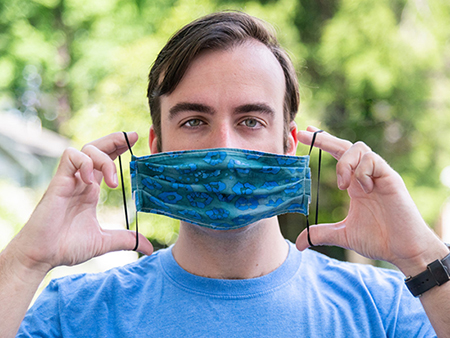Media Contact: Adam Pope
Editor's Note: The information published in this story is accurate at the time of publication. Always refer to uab.edu/uabunited for UAB's current guidelines and recommendations relating to COVID-19.
 Photography: Lexi CoonWearing a mask is a crucial tactic in preventing the spread of COVID-19, but it presents a unique challenge to those who rely on lip-reading to communicate, says Melody Mathews, Au.D., an audiologist at the Kirklin Clinic of UAB.
Photography: Lexi CoonWearing a mask is a crucial tactic in preventing the spread of COVID-19, but it presents a unique challenge to those who rely on lip-reading to communicate, says Melody Mathews, Au.D., an audiologist at the Kirklin Clinic of UAB.
Most people who are deaf and hearing-impaired depend on the ability to read lips in order to converse with others, and a facial covering that impedes communication can increase frustration and affect their mental health, Mathews says.
“A great deal of individuals with hearing impairment, no matter the degree, utilize some degree of lip-reading while communicating,” Mathews said.
Various materials used to make masks also can muffle speaking volume, making it more difficult to hear what others are saying even among people without hearing loss. Many people do not realize they rely on visual cues to aid auditory information while conversing, Mathews says.
“When the volume of speech is reduced, the listener must concentrate harder to understand and follow the communication,” she said. “Couple this reduction in volume with the inability to lip-read, and it can make it very frustrating for hard-of-hearing and deaf individuals, as well as the general population.”
How you can helpUAB is requiring facemasks for all employees and students upon their return to campus, and UAB Disability Support Services offers tips to help Blazers communicate more effectively with colleagues who are deaf or hearing-impaired.
|
In clinical settings, Mathews and her colleagues use facemasks with inserts or clear masks that enable patients to view their mouths when they speak. The masks still protect the speaker and the patient from virus transmission, she says, but they ensure the patient can read their lips.
“I’ve seen patients light up when they realize they can still see my mouth, and they have a much more positive outcome from their visit,” she said.
 Mathews and other audiologists are encouraging hard-of-hearing and deaf individuals to advocate for themselves, such as asking others to communicate in different ways and through different mediums, including writing things on a whiteboard or notepad, using a clear mask when conversing, slowing down their speech, and repeating themselves when necessary. Businesses can keep masks with clear inserts available for employees to wear when a customer is struggling to follow a conversation, she says, and the use of whiteboards and digital systems for ordering and check-in also helps customers navigate the business with a reduced need to communicate orally.
Mathews and other audiologists are encouraging hard-of-hearing and deaf individuals to advocate for themselves, such as asking others to communicate in different ways and through different mediums, including writing things on a whiteboard or notepad, using a clear mask when conversing, slowing down their speech, and repeating themselves when necessary. Businesses can keep masks with clear inserts available for employees to wear when a customer is struggling to follow a conversation, she says, and the use of whiteboards and digital systems for ordering and check-in also helps customers navigate the business with a reduced need to communicate orally.
“The biggest way to help is to try to accommodate these individuals as well as possible through changes in communication methods, and also to encourage those individuals who may feel discouraged,” Mathews said.
Click here to learn more about the Audiology group in the UAB Department of Otolaryngology.